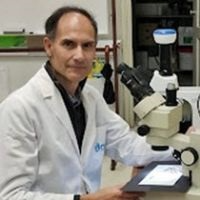Algae—a Step Forward in the Sustainability of Resources
A special issue of Life (ISSN 2075-1729). This special issue belongs to the section "Microbiology".
Deadline for manuscript submissions: closed (27 October 2023) | Viewed by 15640
Special Issue Editors
Interests: algal biotechnology; microalgae; cyanobacteria; seaweeds; bioactive compounds; algal process optimization; algal extraction; wastewater treatment; applications of algae biomass
Special Issues, Collections and Topics in MDPI journals
Interests: antioxidants; free radicals; inflammation; iNOS; LOX; phlorotannins; carotenoids; phenols; seaweeds; HPLC
Special Issues, Collections and Topics in MDPI journals
Interests: marine biotechnology; phycology; biodiversity; nutraceuticals
Special Issues, Collections and Topics in MDPI journals
Special Issue Information
Dear Colleagues,
Planet resources are being depleted earlier every year. Climate change, loss of biodiversity, loss of ecosystem services, land degradation, and air and water pollution is a part of our present and near future.
Eukaryotic and prokaryotic algae have a crucial role in ecosystems, not only because they are the energy base of the food web for all aquatic organisms, but also due to their ability to capture CO2 and produce oxygen. As autotrophic organisms, algae convert water, carbon dioxide, and some nitrogen and phosphorus sources into biomass that can be used as a source of high-value compounds, food/feed, and energy. Besides, their fast growth, and the no need for arable land or potable water, makes these organisms an exceptional sustainable source of eco-friendly products.
Hence, we welcome the submission of high-quality research articles, review articles, and short communications that provide recent insights into several aspects of how algae (seaweeds, microalgae, and cyanobacteria) can positively contribute, or have a role, towards more sustainable use of resources. We encourage submissions related to: algal biotechnology; algal processes or processes that include algae; screenings for exploitation of new species or new applications for known species; optimization of cultivation/production/extraction of algal biomass and their products; algal eco-services; algal products obtained in a biorefinery strategy; and with the role of algae in promotion of a circular economy, within the following topics:
- Health: Bioactive compounds from algae, source of pharmaceuticals, nutraceuticals and cosmetics.
- Food/Feed: ingredient for feed/food formulations, food/feed preservatives, nutraceuticals, algae as a food/feed source, Integrated Multithrophic Aquaculture (IMTA).- Environment: Water treatment/polishing, biofuels production, ecosystems restoration, CO2 sequestration/capture, life cycle assessment of algal processes or involving algae, biofertilizers, biopesticides, green extraction of algal compounds.
Dr. Helena Amaro
Dr. Graciliana Lopes
Prof. Dr. Leonel Pereira
Guest Editors
Manuscript Submission Information
Manuscripts should be submitted online at www.mdpi.com by registering and logging in to this website. Once you are registered, click here to go to the submission form. Manuscripts can be submitted until the deadline. All submissions that pass pre-check are peer-reviewed. Accepted papers will be published continuously in the journal (as soon as accepted) and will be listed together on the special issue website. Research articles, review articles as well as short communications are invited. For planned papers, a title and short abstract (about 100 words) can be sent to the Editorial Office for announcement on this website.
Submitted manuscripts should not have been published previously, nor be under consideration for publication elsewhere (except conference proceedings papers). All manuscripts are thoroughly refereed through a single-blind peer-review process. A guide for authors and other relevant information for submission of manuscripts is available on the Instructions for Authors page. Life is an international peer-reviewed open access monthly journal published by MDPI.
Please visit the Instructions for Authors page before submitting a manuscript. The Article Processing Charge (APC) for publication in this open access journal is 2600 CHF (Swiss Francs). Submitted papers should be well formatted and use good English. Authors may use MDPI's English editing service prior to publication or during author revisions.
Keywords
- macroalgae
- microalgae
- cyanobacteria
- bioactive compounds
- biomass production
- pharmaceuticals
- nutraceuticals
- cosmetics
- food/feed
- CO2 sequestrations
- water treatment
- imta
- ecosystems services
- biofuels
- biopesticides
- green extraction methods








